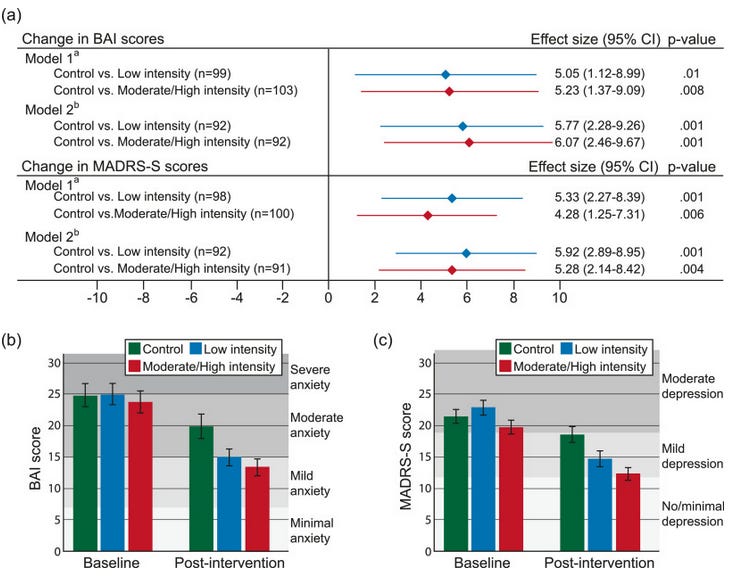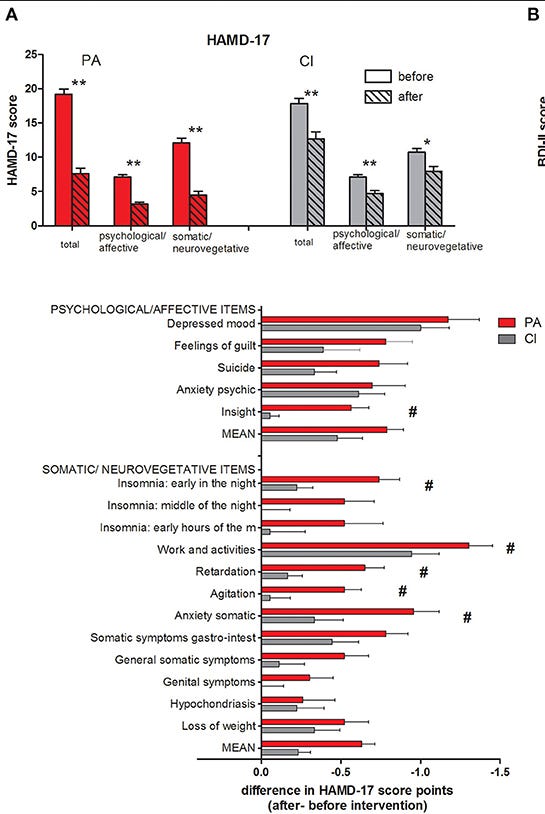The good news about depression – Part 2
Physical activity not only reduces your risk of becoming anxious or depressed, it increases your chances of recovering.
In Part 1 of this mini-series, I summarised the burgeoning body of research on the role that our eating habits play in our predilection to, and likelihood of recovering from, depression and anxiety. The quick and dirty summary of what that research shows is 'eat your dang fruits and vegetables'.
Now, in Part 2, I'm going to delve into recent research on the link between physical activity and the prevention and treatment of depression and anxiety.
Physical activity, depression and anxiety: Get off your dang tush and move your body
I've discussed previous research demonstrating the benefits of physical activity for preventing and alleviating depression and anxiety in 5 surprising benefits of exercise you never knew about and Real answers to the mental health crisis. And the studies just keep coming.
Study #1 - High Sitting Time Is a Behavioral Risk Factor for Blunted Improvement in Depression Across 8 Weeks of the COVID-19 Pandemic in April–May 2020
The title of this study pretty much gives you the punch line. Researchers analysed survey data from 2327 people from all 50 US states and the District of Colombia, gathered at 9 time points between April and June 2020.
They found that while most participants reported a sharp increase in symptoms of depression when stay-at-home and work-from-home policies were first implemented, those who spent fewer hours on their rear ends in the latter months of the study period than the early months were more likely to report that their mood had improved after the initial confinement-related crash.
In contrast, people whose daily sitting time increased during the manufactured COVID-19 crisis, and who remained more sedentary as "two weeks to flatten the curve" turned into months of state-imposed home incarceration, were more likely to still be reporting increased symptoms of depression by the end of the study period.
In other words,
"Sitting more was associated with a slower and limited improvement in depressive symptoms."
Incidentally, this study did not find a buffering effect of moderate to vigorous physical activity on sitting-induced deterioration in psychological well-being. Or, in plain English, working out doesn't compensate for sitting on your butt all day. You really do need to get off your dang tush, at very regular intervals, to avoid spiralling into depression.
Study #2 – Prevalence and variability of current depressive disorder in 27 European countries: a population-based study
Remember that survey of over 250 000 Europeans that found that people who ate fruits and vegetables less than once per week were around three times more likely to be depressed? The researchers also quizzed participants on their physical activity level.
Those who responded that they were physically active (defined as "doing activities that cause at least a small increase in breathing or heart rate for at least 10 min continuously") on zero days per week - a shocking 53 per cent of surveyed men and 58% per cent of women - were the most likely to be depressed. 6 per cent of men and 9 per cent of women who reported that they essentially got no physical activity fulfilled the diagnostic criteria for depression.
Unlike fruit and vegetable intake, there did not appear to be a dose-response relationship between frequency of physical activity and depression in this study. The lowest prevalence of current depression - 2.61 per cent - occurred in men who were physically active 5 days per week, whilst in women, those who were physically active only 3 times per week had the lowest prevalence - 5.2 per cent. It's possible that work-related physical activity was a confound to this study; as noted in Part 1, the same study found that low income earners were more likely to be depressed than high earners, and low-paying jobs are more likely to involve physical activity than high-paying jobs.
Study #3 - Physical Activity Is Associated With Lower Long-Term Incidence of Anxiety in a Population-Based, Large-Scale Study
In this impressive study, Swedish researchers followed nearly 400 000 people who participated in an ultralong-distance cross-country ski race, for up to 21 years, to investigate the connection between physical activity levels and the risk of developing anxiety.
Compared to non-skiiers matched for age and other characteristics, drawn from a nationwide patient register, participants in the ski race - which requires a high level of cardiorespiratory fitness gained through months of intense pre-race training - were roughly 60 per cent less likely to develop anxiety disorders over the course of follow-up.
The protective effects of participation in the ski race were observed in both men and women, although women who finished the race in the shortest time had a higher risk of developing an anxiety disorder than slower skiiers. Notably, however, even the high-performing women had a lower risk of anxiety than matched non-skiing females from the general population.
To explain their findings, the researchers cited other studies that have investigated the beneficial effect of exercise on neurotransmitters such as dopamine, the cortisol response to stress, brain-derived neurotrophic growth factor (BDNF), inflammation and oxidative stress, all of which are involved in the development and perpetuation of anxiety. (Notably, in mice at least, the increased dopamine signalling within the brain triggered by daily exercise persists for a week after the physical activity has ceased.)
And of course, long-distance cross-country skiing gets you out in nature, which I'll discuss in Part 3.
Study #4 - Effects of exercise on symptoms of anxiety in primary care patients: A randomized controlled trial
Prevention of anxiety is one thing, but, you may ask, what about treatment of anxiety that has already developed? Don't worry, another team of Swedish researchers has answered that question.
The researchers recruited patients who had been diagnosed with an anxiety disorder, and randomised 223 individuals - more than half of whom had been living with anxiety for more than 10 years - to participate in one of three groups:
A 12 week group exercise program with low-intensity training consisting of a 1 hour circuit training session 3 times per week;
A 12 week group exercise program with moderate to high-intensity training (the same 1 hour circuit training, but done at a harder pace) 3 times per week, with an additional running session per week; or
A control group which received one session with a physiotherapist who provided general advice about physical activity according to public health recommendations and, after study completion, a 3-month membership at a fitness facility.
Participants were discouraged from participating in any other form of exercise during the trial.
All participants in the study experienced a decrease in their scores on a standardised questionnaire - the Beck Anxiety Inventory (BAI) - which in itself is interesting.
However, participants in both the low-intensity and high-intensity exercise interventions had a significantly greater improvement, scoring approximately 5 points lower on the BAI than the control group as well as reporting lower levels of inner tension on the Montgomery-Åsberg Depression Rating Scale (MADRS-S, item 2), with a trend toward greater improvement in the high-intensity exercise group:
You'll also observe from the chart above that the scores of participants in the exercise interventions moved from the "moderate to severe anxiety" and "moderate depression" ranges to the "mild anxiety" and "mild depression" ranges after they finished their 12 week programs.
In other words, even in chronically anxious people, increasing physical activity to a level that's easily achievable for most people significantly decreases anxiety, to the point where it's a reasonably minor impediment to participating in the activities of daily living rather than a major handicap.
Study #5 - Physical Activity Reduces Clinical Symptoms and Restores Neuroplasticity in Major Depression
Does increasing physical activity have a similarly beneficial effect on people who are already depressed? Yes indeedy.
German researchers tested the effects of an exercise program lasting just three weeks on not just the symptoms of depression, but also neuroplasticity (measured through the use of transcranial magnetic stimulation), in people diagnosed with major depressive disorder (MDD).
It's been known for some time that neuroplasticity - the ability of the brain to change - is reduced in depressed people, with more severe depression correlated with reduced neuroplasticity. In other words, when your brain is stuck in a rut, you are liable to become more and more depressed.
As I mentioned in The latest depressing news on antidepressant drugs, evolutionary psychologists understand depression as an adaptive behaviour that evolved to keep people focused on the source of their distress until they come up with a solution to resolve the relevant problem.
However, if you keep ruminating endlessly on your problem rather than coming up with a solution - or recruiting support from others to help you solve it - the depressed state can become maladaptive.
Enter physical activity. The German team randomised 50 patients admitted to a psychiatric hospital for major depressive disorder into either a three-week exercise program that consisted of three sessions per week of interactive, non-competitive games that combined physical and cognitive tasks, or a control program of two sessions per week of cooperative games with only a cognitive component.
This ingenious study design controlled for the therapeutic effects of both the presence of an instructor and group cohesion, leaving physical activity as the only variable that differed between the intervention and control groups.
While both the exercise and control groups had lower scores on two measures of depression - the self-rated Beck Depression Inventory II (BDI-II) and the investigator-rated Hamilton Depression Scale (HAMD-17) by the end of the study, those in the exercise group showed more pronounced improvements on the HAMD-17 - which is considered more sensitive at detecting changes in depressed people - and only those in the exercise group showed improvements in their brain's ability to change.
In fact, after three weeks' participation in the exercise intervention, neuroplasticity was restored to the same values as in non-depressed people. In other words, a pretty low-key physical activity program corrected one of the principal neurological features of major depression - the inability of the brain to learn and adapt to change.
Considering this finding through an evolutionary lens, our ancient ancestors would have been forced to remain physically active even when depressed, in order to survive. And, as discussed in my previous article, Should you choose a nice stroll or a killer workout? It depends on which problem you’re trying to solve, low-intensity exercise such as that used in the German study intervention is superior for helping individuals to focus their attention on tasks that require a great deal of concentration and rigorous thought.
In that light, it's notable that one of the most significant differences between the exercise and control groups was in insight, which in this context roughly translates to self-awareness, a crucial prerequisite for recovery. Other markers which significantly improved in the exercise group were onset insomnia, ability to engage in work and activities, retardation (slowing of thought and movement), agitation, and bodily symptoms of anxiety, which point to an increased capacity of individuals to solve their problems and reengage in life:
Accordingly, as the lead author of the study noted,
“The more the ability to change increased, the more clearly the clinical symptoms decreased.”
Physical Activity Jolts Brain Into Action in the Event of Depression
Study #6 - The longitudinal associations of physical activity, time spent outdoors in nature and symptoms of depression and anxiety during COVID-19 quarantine and social distancing in the United States
This study tracked over 20 000 adults who participated in the US Kaiser Permanente Research Bank - a collection of lifestyle surveys, electronic health record data, and biospecimens from people enrolled in one of the largest nonprofit healthcare plans in America - over the first several months of the manufactured COVID crisis (April-August 2020).
During this time, unprecedented and non-evidence-based diktats masquerading as "public health measures" such as stay-at-home orders and closure of gyms and national parks - were imposed in the majority of US states.
The Kaiser Permanente study found that
"Participants in the lowest physical activity category (no reported physical activity) had the highest depression and anxiety scores compared to each successive physical activity category across follow-up... Each higher physical activity category had lower depression and anxiety scores."
In other words, there was a dose-response relationship between physical activity and the prevalence of both anxiety and depression; the more activity participants engaged in, the higher was their psychological well-being.
I'll discuss the "time spent outdoors in nature" aspect of this study in Part 3 of this series. Stay tuned!





